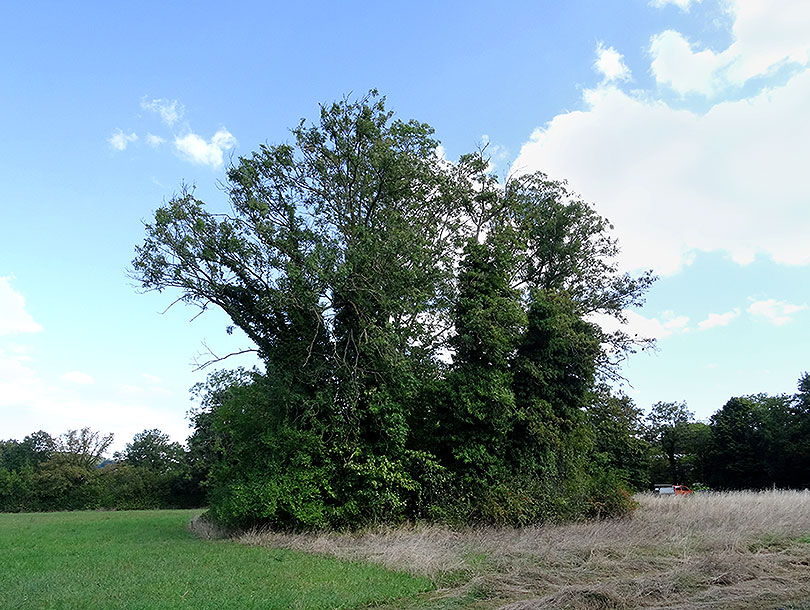Natural diversity between asphalt and concrete
Text: Yvonne Vahlensieck
The Canton of Basel-Stadt contains numerous woodlets, many of them in the city. Now, for the first time, a conservation biologist at the University of Basel is studying the ecosystem functions of these green islands in urban space.
At first, forestry research in a city does not exactly sound promising. However, a look at the statistics shows that Basel- Stadt has over four square kilometers of forest. Most of this consists not of large, continuous areas, but of several small parcels of land. These are the remnants of what were once large forests, overgrown orchards or plots that have become reforested.
Yet, can these somewhat random collections of trees in a settlement area still be described as forest? A forest serves as an ecosystem in a large number of ways – for example by offering diverse habitats for animals and plants, improving soil quality, storing water, and cleaning the air. Can small forest fragments fulfil the same role?
Ramona Melliger of the Institute of Environmental Sciences at the University of Basel is tackling this precise question. In her doctoral research, she examined 27 forest fragments of differing sizes and in different parts of the city. The largest forest examined was around 50,000 square meters in Bettingen, the smallest a former orchard in Riehen measuring 258 square meters, about the size of a tennis court. Other forest fragments were surveyed in the Bruderholz district, by the Rhine and near the Wolf goods depot.
Home to many plant species
The first and most important step in the study was recording the plant species growing in the forest fragments selected. “Plants are essential to the functioning of an ecosystem,” explains Melliger. “Animals play a role too, but plants to an extent form the backbone of an ecosystem.” To record the species, she installed six randomly selected squares measuring four times four meters in each forest fragment. She then documented every species found within these squares: from trees and shrubs to herbs and ferns. In spring, Melliger walked, cycled or took the tram to reach her research objects to catch as many plants as possible in the act of blooming/flowering – the easiest way to identify a species.
Even the initial results were somewhat surprising. “You would assume that the larger the forest, the more species there would be,” says Melliger. However, the statistical analysis showed no relationship between the size of the forest fragment and the number of species found. For example, Melliger counted over 30 different plant species in a small forest the size of a tennis court, while some larger areas contained fewer species.
Roads and tracks hinder diversity
Still, the sheer number of species is not the only crucial factor in a healthy and stable ecosystem – the balanced relationship between the species and their abundance, or diversity, is also important. “If a plant occurs only in small numbers, then this species will make very little contribution to the ecosystem,” explains Melliger. Therefore, when visiting small forest fragments she also counted how many times each species occurred. The smaller forest fragments scored significantly worse in this respect: The ground was often dominated by a single species of plant, such as ivy, while other species occurred only occasionally.
Diversity was particularly low in areas with a high building density. One prime example is the forest near the Wolf goods depot, which is completely surrounded by tracks, roads with several lanes, and buildings. “Plant diversity is very low here – the ground is almost completely covered by ivy and wild garlic,” Melliger notes. Concreted and builtover areas act as a barrier for many plant seeds. In particular, species that primarily spread via roots or shoots have practically no chance to gain a foothold in such isolated fragments. In addition to diversity,
Melliger identified another key difference between large and small areas: Larger forests house many shade-tolerant plants such as the early dog-violet. In small forest fragments, Melliger tended to find species that typically occur on forest edges or hedge plants such as the graybeard. This is due to the edge effect: Small forests have proportionally more edge in relation to their area and therefore offer more habitat for species that require light and heat.
Spiders indicate disturbance
The effects of the differences in species composition identified on ecosystem functioning are not yet clear: For example, can these tiny forest fragments provide a home for a range of organisms? To answer this question, Melliger is now looking at the spider diversity in the forests examined: “Spiders have been shown to be good indicators of disturbances in ecosystems.” In addition, spiders are so numerous that it is easy to collect sufficient samples. Last year,
Melliger buried more than 1,500 plastic beakers filled with soapy water in the forest soil – simple ground traps for spiders. The specimens caught using this method have not yet been counted and identified, but Melliger anticipates a yield of several thousand spiders from at least 60 different species. The composition and abundance of the species will then allow further conclusions on the health of the city’s forests. Studies on ant diversity and the decomposition rate of leaves are also underway.
This will gradually produce a complete picture of the forest fragments in Basel. It will then become apparent whether, despite all these differences, they can contribute as much to the ecosystem services as large forests. For Professor Bruno Baur, Professor of Conservation Biology at the Institute, it is high time that more research projects of this type were performed: “By now, 80 percent of the world’s population lives in cities – and this figure is increasing. Green spaces such as these urban woodlands will play a significant role in the wellbeing of city dwellers in the future.”

